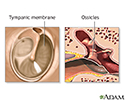Eardrum repair
Myringoplasty; Tympanoplasty; Ossiculoplasty; Ossicular reconstruction; Tympanosclerosis - surgery; Ossicular discontinuity - surgery; Ossicular fixation - surgery
Eardrum repair refers to one or more surgical procedures that are done to correct a tear or other damage to the eardrum (tympanic membrane).
Ossiculoplasty is the repair of the small bones in the middle ear.
Description
Most adults (and all children) receive general anesthesia for this surgery. This means you'll be asleep and unable to feel pain. Sometimes, local anesthesia is used along with medicine that makes you sleepy.
Your surgeon will make a cut behind the ear or inside the ear canal.
Depending on the problem, your surgeon will:
- Clean out any infection or dead tissue on the eardrum or in the middle ear.
- Patch the eardrum with a piece of the patient's own tissue taken from a vein or muscle sheath (called tympanoplasty). This procedure will usually take 2 to 3 hours.
- Remove, replace, or repair 1 or more of the 3 little bones in the middle ear (called ossiculoplasty).
- Repair smaller holes in the eardrum by placing either gel or a special paper over the eardrum (called myringoplasty). This procedure will usually take 10 to 30 minutes.
Your surgeon will use an operating microscope to view and repair the eardrum or the small bones.
Why the Procedure Is Performed
The eardrum is between the outer ear and the middle ear. It vibrates when sound waves strike it. When the eardrum is damaged or has a hole in it, hearing may be reduced and ear infections may be more likely.
Causes of holes or openings in the eardrum include:
- A bad ear infection
- Dysfunction of the eustachian tube
- Sticking something inside the ear canal
- Surgery to place ear tubes
- Trauma
If the eardrum has a small hole, myringoplasty may work to close it. Most of the time, your health care provider will wait at least 6 weeks after the hole developed before suggesting surgery.
Tympanoplasty may be done if:
- The eardrum has a larger hole or opening
- There is a chronic infection in the ear, and antibiotics do not help
- There is a buildup of extra tissue around or behind the eardrum
These same problems can also harm the very small bones (ossicles) that are right behind the eardrum. If this happens, your surgeon may perform an ossiculoplasty.
Risks
Risks of anesthesia and surgery in general are:
- Reactions to medicines
- Breathing problems
- Bleeding, blood clots, infection
Risks of this procedure include:
- Damage to the facial nerve or nerve controlling the sense of taste
- Damage to the small bones in the middle ear, causing hearing loss
- Dizziness or vertigo
- Incomplete healing of the hole in the eardrum
- Worsening of hearing, or, in rare cases, complete loss of hearing
Before the Procedure
Tell your surgeon:
- What allergies you or your child may have to any medicines, latex, tape, or skin cleanser
- What medicines you or your child is taking, including herbs and vitamins you bought without a prescription
On the day of the surgery for children:
- Follow instructions about not eating or drinking. For infants, this includes breastfeeding.
- Take any needed medicines with a small sip of water.
- If you or your child is ill on the morning of surgery, call the surgeon right away. The procedure will need to be rescheduled.
- Arrive at the hospital on time.
After the Procedure
You or your child may leave the hospital the same day as the surgery, but may need to stay the night in case of any complications.
To protect the ear after surgery:
- Packing will be placed in the ear for the first 5 to 7 days.
- Sometimes a dressing covers the ear itself.
Until your provider says it is OK:
- Do not allow water to get into the ear. When showering or washing your hair, place cotton in the outer ear and cover it with petroleum jelly. An option to using cotton and petroleum jelly is to wear a shower cap pulled down to cover your ears.
- Do not "pop" your ears or blow your nose. If you need to sneeze, do so with your mouth. Draw any mucus in your nose back into your throat.
- Avoid air travel and swimming.
Gently wipe away any ear drainage on the outside of the ear. You may get eardrops the first week. Do not put anything else into the ear.
If you have stitches behind the ear and they get wet, gently dry the area. Do not rub.
You or your child may feel pulsing, or hear popping, clicking, or other sounds in the ear. The ear may feel full or as if it is filled with liquid. There may be sharp, shooting pains off and on soon after the surgery.
To avoid catching a cold, stay away from crowded places and people with cold symptoms.
Outlook (Prognosis)
In most cases, the pain and symptoms are completely relieved. Hearing loss is minor.
The outcome may not be as good if the bones in the middle ear need to be reconstructed, along with the eardrum.
References
Adams ME, El-Kashlan HK. Tympanoplasty and ossiculoplasty. In: Flint PW, Francis HW, Haughey BH, et al, eds. Cummings Otolaryngology: Head and Neck Surgery. 7th ed. Philadelphia, PA: Elsevier; 2021:chap 142.
Chiffer R, Chen D. Myringoplasty and tympanoplasty. In: Eugene M, Snyderman CH, eds. Operative Otolaryngology Head and Neck Surgery. 3rd ed. Philadelphia, PA: Elsevier; 2018:chap 131.
Fayad JN, Sheehy JL. Tympanoplasty: outer surface grafting technique. In: Brackmann DE, Shelton C, Arriaga MA, eds. Otologic Surgery. 5th ed. Philadelphia, PA: Elsevier; 2023:chap 8.
Review Date: 5/2/2024
Reviewed By: Josef Shargorodsky, MD, MPH, Johns Hopkins University School of Medicine, Baltimore, MD. Also reviewed by David C. Dugdale, MD, Medical Director, Brenda Conaway, Editorial Director, and the A.D.A.M. Editorial team.








